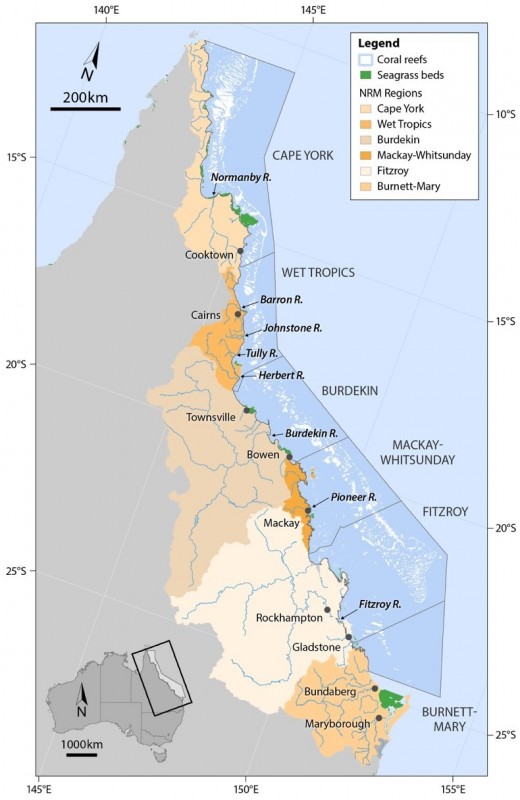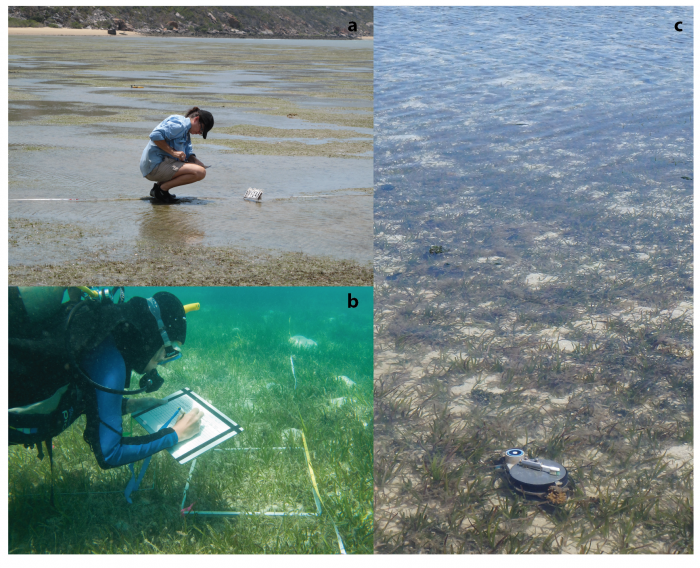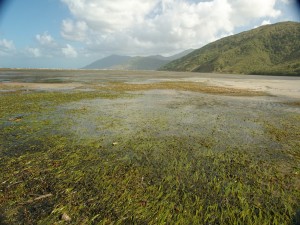Reef Rescue Marine Monitoring Program - Project - Inshore Seagrass monitoring program (JCU) - Deprecated

The Marine Monitoring Program (MMP) undertaken in the Great Barrier Reef (GBR) lagoon, assesses the long-term effectiveness of the Australian and Queensland Government’s Reef Water Quality Improvement Plan (Reef Plan). The MMP, established in 2005, is a critical component in the Paddock to Reef Integrated Monitoring Modelling and Reporting Program (P2R) that tracks changes in regional water quality and its impact on the GBR as land management practices are improved across Reef catchments.
Seagrass monitoring occurs in the inshore seagrass meadows of all Natural Resource Management regions of the GBR (Figure 1, (McKenzie et al. 2018)). Fifty eight sites at 29 locations are assessed including nine coastal, four estuarine and twelve reef locations (i.e. two or three sites at each location). At the reef locations in the Wet Tropics, Burdekin and Fitzroy regions, intertidal sites are paired with a subtidal site. Apart from the 42 MMP long-term monitoring sites, data included eight sites from Seagrass-Watch and eight sites from QPWS to improve the spatial resolution and additional subtidal habitats where possible. The inshore seagrass component of the MMP assessed seagrass abundance (per cent cover), reproductive effort, and leaf tissue nutrients from inshore seagrass meadows at 29 locations across the GBR. These three indicators are scored for each of the six Natural Resource Management regions for the annual Reef Plan report card. A full description of methods can be found in the annual report and the QA/QC document.
In the 2016-17 monitoring period, the overall seagrass score based on these three indicators was poor (GBR average) and it was poor in all regions except the Burdekin (Table 1). Seagrass abundance has been increasing at most locations since 2010-11 (Figure 3). Prior to that, there were widespread declines (in 2008-09, 2009-10 and 2010-11) in seagrass abundance, which were the result of above average rainfall and climate-related impacts. The average score in 2010-11 was very poor.
Additional indicators of seagrass condition and resilience are assessed and used to assist with the interpretation of the Report Card score, including: seagrass species composition, relative meadow extent and density of seeds in the seed bank. Environmental pressures are also recorded including within-canopy water temperature, within-canopy benthic light, sediment composition as well as macroalgae and epiphyte abundance. There is further data on climate and water quality obtained from the Australian Bureau of Meteorology and from the MMP inshore water quality subprogram.
This monitoring program provides information on seagrass condition and resilience in the GBR, which is vital information as seagrasses are an important component of the marine ecosystem. Certain seagrasses are the primary food for marine green turtles and dugongs, which are seagrass specialists. Therefore, previous reductions in seagrass abundance had significant flow-on negative effects to dugong and green turtle populations (Meager and Limpus 2012). Seagrass form highly productive habitats for a large number of invertebrates, fish and algal species, which important to commercial (e.g. prawns) and subsistence fisheries. Seagrass also produce natural biocides and improve water quality by controlling pathogenic bacteria to the benefit of humans, fishes, and marine invertebrates such as coral (Lamb et al. 2017). Nutrient cycling in seagrass meadows makes them one of the most economically valuable ecosystems in the world (Costanza et al. 1997) and the retention of carbon within their sediments contributes significantly to Blue Carbon sequestration (Fourqurean et al. 2012, Unsworth et al. 2012, Duarte and Krause-Jensen 2017, Macreadie et al. 2017).
Further information on how the reef is managed is available at the Great Barrier Reef Marine Park Authority website.
References
Costanza, R., R. d'Arge, R. de Groot, S. Farber, M. Grasso, B. Hannon, K. Limburg, S. Naeem, R. V. O'Neil, J. Paruelo, R. G. Raskin, P. Sutton, and M. van der Belt. 1997. The Value of the world's ecosystem services and natural capital. Nature 387:253-260.
Duarte, C. M., and D. Krause-Jensen. 2017. Export from Seagrass Meadows Contributes to Marine Carbon Sequestration. Frontiers in Marine Science 4.
Fourqurean, J. W., C. M. Duarte, H. Kennedy, N. Marba, M. Holmer, M. A. Mateo, E. T. Apostolaki, G. A. Kendrick, D. Krause-Jensen, K. J. McGlathery, and O. Serrano. 2012. Seagrass ecosystems as a globally significant carbon stock. Nature Geoscience 5:505-509.
Lamb, J. B., J. A. J. M. van de Water, D. G. Bourne, C. Altier, M. Y. Hein, E. A. Fiorenza, N. Abu, J. Jompa, and C. D. Harvell. 2017. Seagrass ecosystems reduce exposure to bacterial pathogens of humans, fishes, and invertebrates. Science 355:731.
Macreadie, P. I., O. Serrano, D. T. Maher, C. M. Duarte, and J. Beardall. 2017. Addressing calcium carbonate cycling in blue carbon accounting. Limnology and Oceanography Letters 2:195-201.
Meager, J. J., and C. J. Limpus. 2012. Marine wildlife stranding and mortality database annual report 2011. III. Marine Turtle. Conservation Technical and Data Report 2012:1-46.
Unsworth, R. K., C. J. Collier, G. M. Henderson, and L. J. McKenzie. 2012. Tropical seagrass meadows modify seawater carbon chemistry: implications for coral reefs impacted by ocean acidification. Environmental Research Letters 7:024026.












